Paper Menu >>
Journal Menu >>
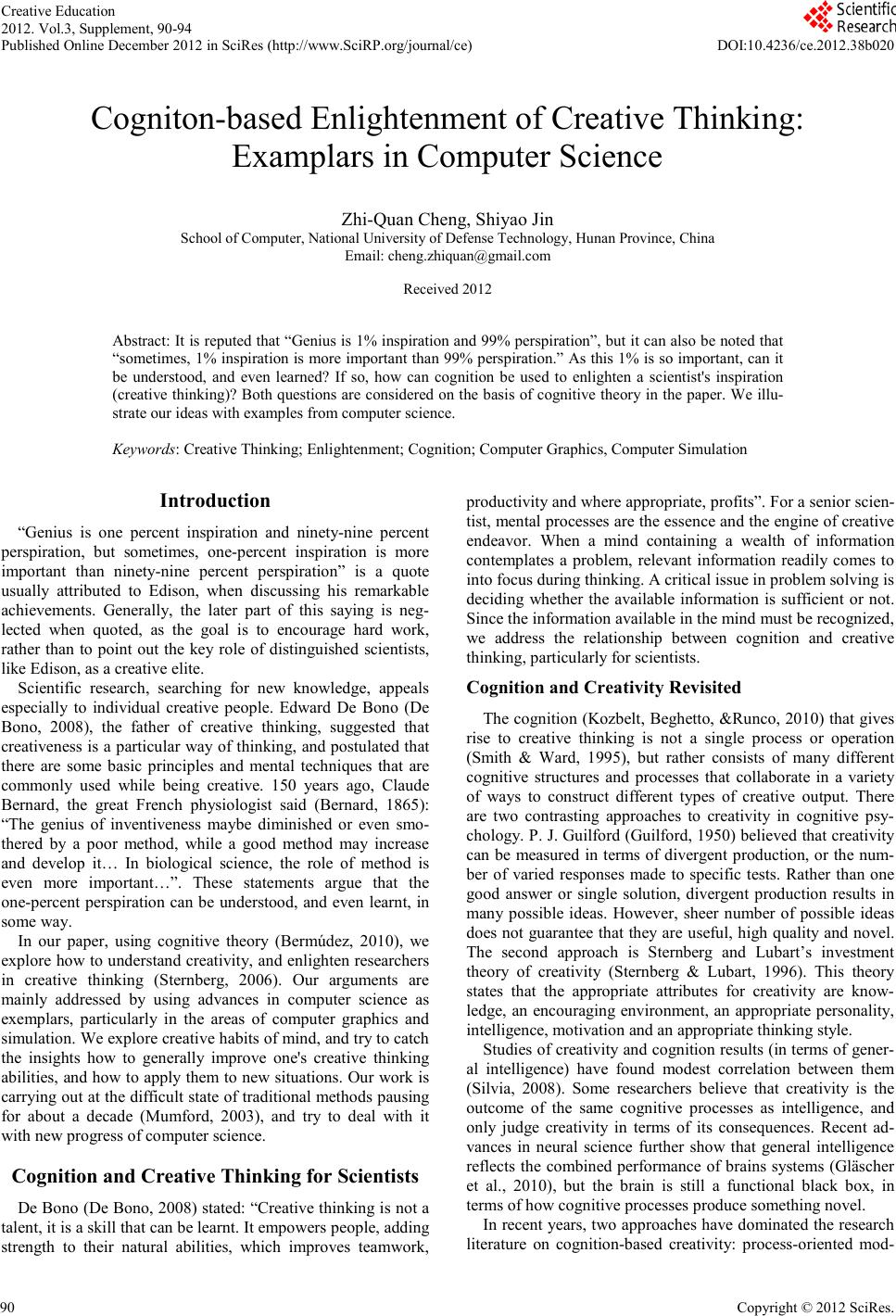 Creat ive Educati on 2012. Vol.3, Supplement, 90-94 Published Online December 2012 in SciRes (http://www.SciRP.org/journal/ce) DOI:10.4236/ce.2012.38b020 Copyright © 2012 SciRes. 90 Cogniton-based Enlightenment of Creative Thinking: Examplars in Computer Sci e nce Zhi-Quan Cheng, Shiyao Jin School of Computer, N ational University of Defense T echnolog y, Hunan Province, China Email: cheng.zhiquan@gmail.com Received 20 1 2 Abstract: It is rep uted that “Genius i s 1% ins piration a nd 99% per spira tion”, but it can al so be noted t hat “sometimes, 1% inspirat ion is more import ant than 99% perspiration.” As this 1% is s o important, ca n it be understood, and even learned? If so, how can cognition be used to enlighten a scientist's inspiration (cr eative thinki ng)? Both ques tions are cons idered on the bas is of cognitive the ory in the pap er. We illu- strat e our ideas with examples fr om comp uter science. Key words: Creat ive Thinking; Enlightenment; Cognit ion; Computer Graphics, Comp uter Simulati on Introduction “Genius is one percent inspiration and ninety-nine percent perspiration, but sometimes, one-percent inspiration is more important than ninety-nine percent perspiration” is a quote usually attributed to Edison, when discussing his remarkable achievements. Generally, the later part of this saying is neg- lected when quoted, as the goal is to encourage hard work, rather than to point out the key role of distinguished scientists, like Edison, as a creati ve elite. Scientific research, searching for new knowledge, appeals especially to individual creative people. Edward De Bono (De Bono, 2008), the father of creative thinking, suggested that creativeness is a particular way of thinking, and postu lated that there are some basic principles and mental techniques that are commonly used while being creative. 150 years ago , Claude Bernard, the great French physiologist said (Bernard, 1865): “The genius of inventiveness maybe diminished or even smo- thered by a poor method, while a good method may increase and develop it… In biological science, the role of method is even more important…”. These statements argue that the one-percent perspiration can be understood, and even learnt, in some way. In our paper, using cognitive theory (Bermúdez, 2010), we explore how to understand creativity, and enlighten researchers in creative thinking (Sternberg, 2006). Our arguments are mainly addressed by using advances in computer science as exemplars, particularly in the areas of computer graphics and simulation. We explore creati ve hab its of min d, and t ry to catch the insights how to generally improve one's creative thinking abilities, and how to apply them to new situations. Our work is carrying out at the difficult state of traditional methods pausing for about a decade (Mumford, 2003), and try to deal with it with new progress of co mputer science. Cognition and Creative Thinking for Scientists De Bono (De B ono, 2008 ) stated: “Creative thinking is not a talent, it is a skill that can be learnt. It empowers people, adding strength to their natural abilities, which improves teamwork, productivity and where appropriate, profits”. For a senior scien- tist, mental pro cesses ar e the ess en ce and the engine of creati ve endeavo r . When a mind containing a wealth of information contemplates a problem, relevant information readily comes to into focus during thinking. A critical issue in problem solving is deciding whether the available information is sufficient or not. Since the information available in the mind must be recognized, we address the relationship between cognition and creative thinking, particularly for scientists. Cognition and Creativity Revisited The cognition (Kozbelt, Beghetto, &Runco, 2010) that gives rise to creative thinking is not a single process or operation (Smith & Ward, 1995), but rather consists of many different cognitive structures and processes that collaborate in a variety of ways to construct different types of creative output. There are two contrasting approaches to creativity in cognitive psy- chology. P. J. Guilford (Guilford, 1950) beli eved that creativit y can be measured in terms of divergent production, or the num- ber of varied responses made to specific tests. Rather than one good answer or single solution, divergent production results in many possible ideas. However, sheer number of possible ideas does not guarantee that they are useful, high quality and novel. The second approach is Sternberg and Lubart’s investment theory of creativity (Sternberg & Lubart, 1996). This theory states that the appropriate attributes for creativity are know- ledge, an encouraging environment, an appropriate personality, intelligence, motivation and an appropriate thinking style. Studies of creativity and cognition results (in terms of gener- al intelligence) have found modest correlation between them (Silvia, 2008). Some researchers believe that creativity is the outcome of the same cognitive processes as intelligence, and only judge creativity in terms of its consequences. Recent ad- vances in neural science further show that general intelligence reflects the combined performance of brains systems (Gläscher et al., 2010), but the brain is still a functional black box, in terms of how cognitive processes produce something novel. In recen t years, two app roaches have d ominated the research literature on cognition-based creativity: process-oriented mod- 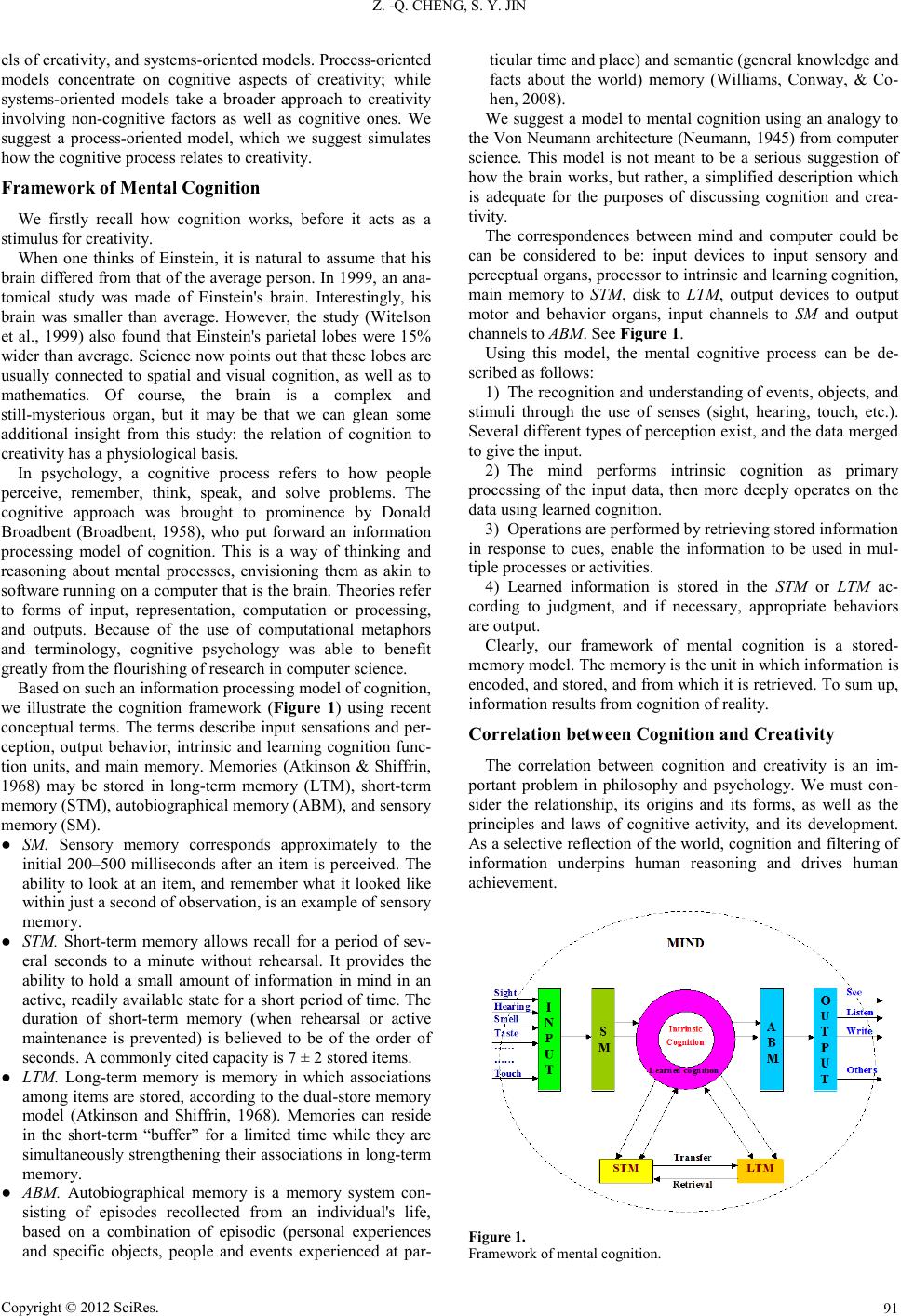 Z. -Q. CHENG, S. Y. JIN Copyright © 2012 SciRes. 91 els of creati vit y, and systems-oriented models. Process-oriented models concentrate on cognitive aspects of creativity; while systems-oriented models take a broader approach to creativity involving non-cognitive factors as well as cognitive ones. We suggest a proces s-oriented model, which we suggest simulates how th e cognitive process relates to creativity. Framework of Menta l Cog nitio n We firstly recall how cognition works, before it acts as a stimulus for cr eativity. When one thinks of Einstein, it is natural to assume that his brain differed from that of the average person . In 1999, an an a- tomical study was made of Einstein's brain. Interestingly, his brain was smaller than average. However, the study (Witelson et al., 1999) also found that Einstein's parietal lobes were 15% wider than average. Science now points out that these lobes are usually connected to spatial and visual cognition, as well as to mathe matics. Of course, the brain is a complex and still-mysterious organ, but it may be that we can glean some additional insight from this study: the relation of cognition to creativity has a physiological basi s. In psychology, a cognitive process refers to how people perceive, remember, think, speak, and solve problems. The cognitive approach was brought to prominence by Donald Broadbent (Broadbent, 1958), who put forward an information processing model of cognition. This is a way of thinking and reason ing about mental processes, envisioning them as akin to software running on a computer that is the brain. Theories refer to forms of input, representation, computation or processing, and outputs. Because of the use of computational metaphors and terminology, cognitive psychology was able to benefit greatly from the flourishing of research in computer science. Based o n such an information processing model of cognition, we illustrate the cognition framework (Figure 1) using recent concep tual terms. The terms describe input sensations and per- ception, output behavior, intrinsic and learning cognition func- tion units, and main memory. Memories (Atkinson & Shiffrin, 1968) may be stored in long-term memory (LTM), short-term memory (STM), autobiographical memory (ABM), and sensory memory (SM). ● SM. Sensory memory corresponds approximately to the initial 200–500 milliseconds after an item is perceived. The ability to look at an item, and remember what it looked like within just a second of observation , is an example of sensory memory. ● STM. Short-term memory allows recall for a period of sev- eral seconds to a minute without rehearsal. It provides the ability to hold a small amount of information in mind in an active, re adily avail able state for a sho rt period of time. The duration of short-term memory (when rehearsal or active maintenance is prevented) is believed to be of the order of seconds. A commonly cited capacity is 7 ± 2 stored items. ● LTM. Long-term memory is memory in which associations among it ems are stored, according to the dual-st or e memo r y model (Atkinson and Shiffrin, 1968). Memories can reside in the short-term “buffer” for a limited time while they are simultaneously strengthening their associations in long-term memory. ● ABM. Autobiographical memory is a memory system con- sisting of episodes recollected from an individual's life, based on a combination of episodic (personal experiences and specific objects, people and events experienced at par- ticul ar ti me and place) an d seman tic ( general kno wledge an d facts about the world) memory (Williams, Conway, & Co- hen, 20 08). We su gg est a mod el to mental cognition using an analogy to the Von Neumann architecture (Neumann, 1945) fro m computer science. This model is not meant to be a serious suggestion of how the brain works, but rather, a simplified description which is adequate for the purposes of discussing cognition and crea- tivity. The correspondences between mind and computer could be can be considered to be: input devices to input sensory and percept ual organs, processor to intrinsic and learning cognition, main memory to STM, disk to LTM, output devices to output motor and behavior organs, input channels to SM and output channels to ABM. See Figure 1. Using this model, the mental cognitive process can be de- scribed as follows: 1) The recognition and under stand ing of events, objects, and stimuli through the use of senses (sight, hearing, touch, etc.). Several di fferent types o f perception exist, and the data merged to give the input. 2) The mind performs intrinsic cognition as primary processing of the input data, then more deeply operates on the data using learned cognition. 3) Operations are performed by retrieving stored information in response to cues, enable the information to be used in mul- tiple processes or activities. 4) Learned information is stored in the STM or LTM ac- cording to judgment, and if necessary, appropriate behaviors are output. Clearl y, our framework of mental cognition is a stored- memory model. The memor y is th e unit in which information is encoded, and stored, and from which it is retrieved. To sum up, information results from cognition of reality. Correlation between Cognition and Creativity The correlation between cognition and creativity is an im- portant problem in philosophy and psychology. We must con- sider the relationship, its origins and its forms, as well as the principles and laws of cognitive activity, and its development. As a selective reflection of the world, cognition and filtering of information underpins human reasoning and drives human achievement. Figure 1. Framework of mental cognition . 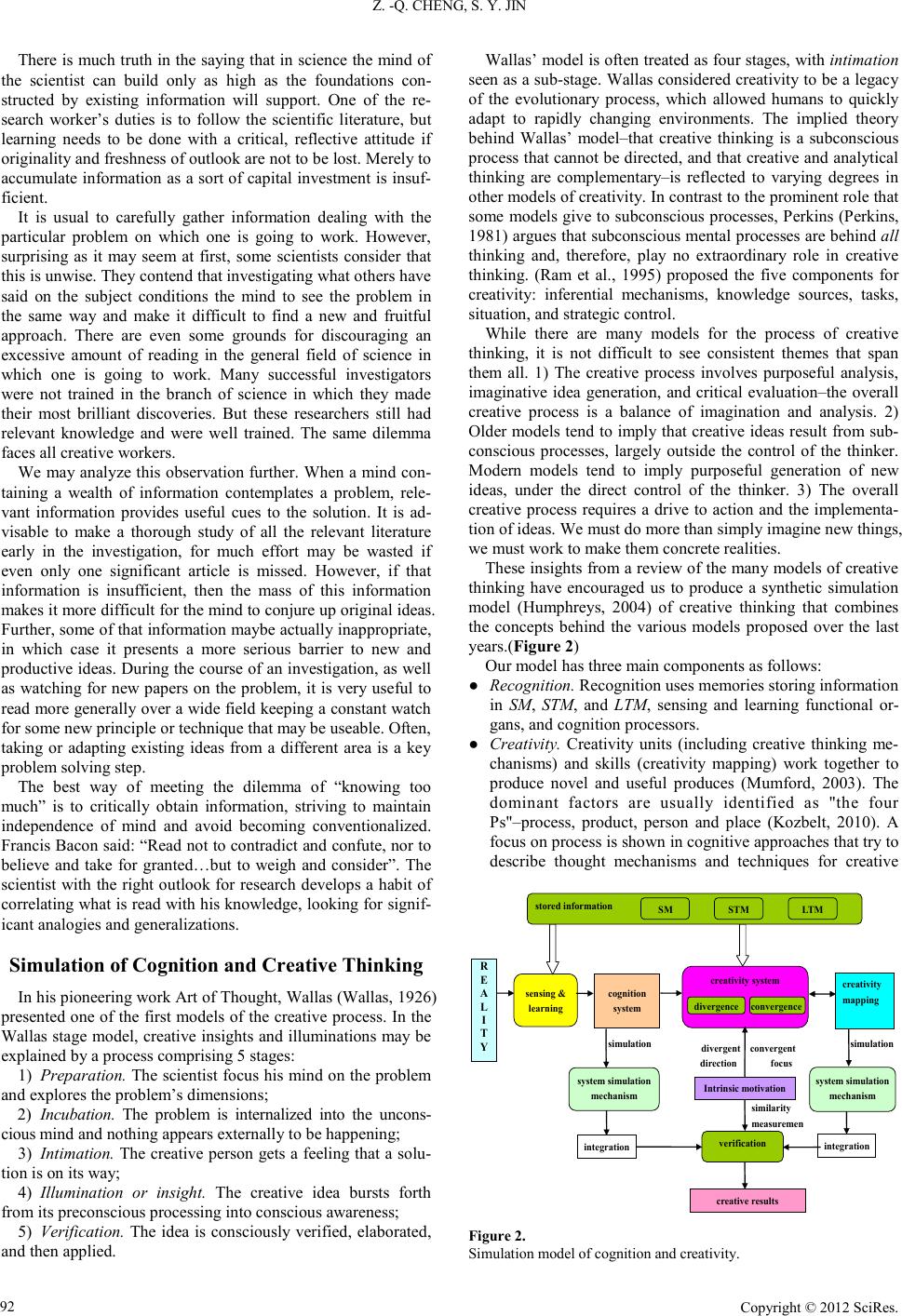 Z. -Q. CHENG, S. Y. JIN Copyright © 2012 SciRes. 92 There is much truth in the saying that in science the mind of the scientist can build only as high as the foundations con- structed by existing information will support. One of the re- search worker’s duties is to follow the scientific literature, but learning needs to be done with a critical, reflective attitude if originality and freshness of outlook are not to be lost. Merely to accumulat e information as a sort of capital investmen t is insuf- ficient. It is usual to carefully gather information dealing with the particular problem on which one is going to work. However, surprising as it may seem at first, some scientists consider that this is unwise. They contend that investigating what others have said on the subject conditions the mind to see the problem in the same way and make it difficult to find a new and fruitful approach. There are even some grounds for discouraging an excessive amount of reading in the general field of science in which one is going to work. Many successful investigators were not trained in the branch of science in which they made their most brilliant discoveries. But these researchers still had relevant knowledge and were well trained. The same dilemma faces all creat i ve wo rker s. We may anal yze this observation further. When a mind con- taining a wealth of information contemplates a problem, rele- vant information provides useful cues to the solution. It is ad- visable to make a thorough study of all the relevant literature early in the investigation, for much effort may be wasted if even only one significant article is missed. Ho wever, if that information is insufficient, then the mass of this information makes it more difficult for the mind to conjure up original ideas. Further, some of that information maybe actually inappropriate, in which case it presents a more serious bar r i er to new and produ ctive ideas. During the course of an investigation, as well as watching for new papers on the problem, it is very useful to read more generall y over a wide field keeping a const ant watch for some n ew pr incipl e or technique that may be useable. Often, taking or adapting existing ideas from a different area is a key problem solving step. The best way of meeting the dilemma of “knowing too much” is to critically obtain information, striving to maintain independence of mind and avoid becoming conventionalized. Franci s Bacon said : “Read not to contradict and confute, nor to believe and take for granted…but to weigh and consider”. The scientist with the right outlook for research develops a habit of correlating what is read with his knowledge, looking for signif- icant analogies an d generalizat i ons. Simulation of Cognition and Creative Thinking In his pion eer in g work Art of Thought, Wallas (Wallas, 1926) presented one of the first models of the creative process. In the Wallas stage model, creative insights and illuminations may be explained by a process comprising 5 stages: 1) Preparation. The scientist focus his mind on the problem and explores the problem’s dimensions; 2) Incubation. The problem is internalized into the uncons- cious mind and nothing appears externally to be happening; 3) Intimation. The creative perso n gets a feeling th at a solu- tion is on its way; 4) Illumination or insight. The creative idea bursts forth from its preconscious processing into conscious awareness; 5) Verification. The idea is consciously veri fied, elaborated, and then applied. Wallas’ model i s often treated as fou r stages, with intimation seen as a su b-stage. Wallas con sidered creativity to b e a legacy of the evolutionary process, which allowed humans to quickly adapt to rapidly changing environments. The implied theory behind Wallas’ model–that creative thinking is a subconscious proces s that cann ot be direct ed, and that cr eative and anal ytical thinking are complementary–is reflected to varying degrees in other models of creativity. In contrast to the prominent role that some models give to subconscious processes, Perkins (Perkins, 1981) argues that subconscious mental processes are b ehind all thinking and, therefore, play no extraordinary role in creative thinking. (Ram et al., 1995) proposed the five components for creativity: inferential mechanisms, knowledge sources, tasks, situation, and strategic control. While there are many models for the process of creative thinking, it is not difficult to see consistent themes that span them all. 1) The creative process involves purposeful analysis, imaginative idea generation, and critical evaluation–the overall creative process is a balance of imagination and analysis. 2) Older models tend to imply that creative ideas result fro m sub- conscious processes, largely outside the control of the thinker. Modern models tend to imply purposeful generation of new ideas, under the direct control of the thinker. 3) The overall creative process requires a drive to action and the implementa- tion of ideas. We must do more than simply imagine new things, we must work t o make them concrete realities. These insi ghts from a revie w of the many model s of creative thinking have encouraged us to produce a synthetic simulation model (Humphreys, 2004) of creative thinking that combines the concepts behind the various models proposed over the last years.(Figure 2) Our model has three main components as follows: ● Recognition. Recognition uses memories storing information in SM, STM, and LTM, sensing and learning functional or- gans, and cognition processors. ● Creativity. Creativity units (including creative thinking me- chani sms) and skills (creativity mapping) work to gether to produce novel and useful produces (Mumford, 2003). The dominant factors are usually identified as "the four Ps"–process, product, person and place (Kozb el t , 2010). A focus on process is shown in cognitive approaches that try to describe thought mechanisms and techniques for creative integration simulation system simulation mechanism R E A L I T Y sensing & learning cognition system creativity system divergence convergence Intrinsic motivation verification integration creative results simulation divergent convergent direction focus similarity measuremen system simulation mechanism stored information STM LTM SM creativity mapping Figure 2. Simu lation model of c ognition and creativity. 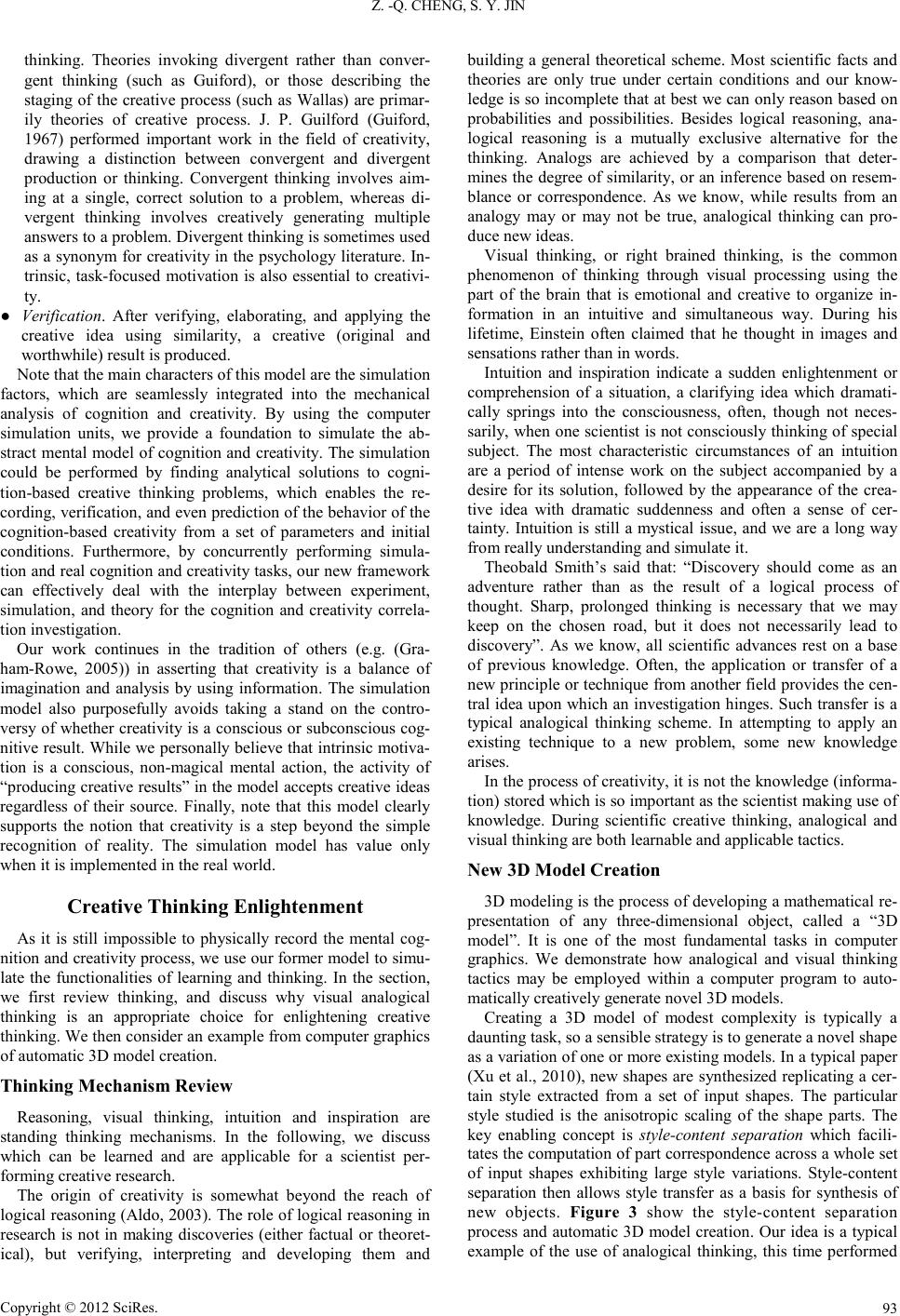 Z. -Q. CHENG, S. Y. JIN Copyright © 2012 SciRes. 93 thinking. Theories invoking divergent rather than conver- gent thinking (such as Guiford), or those describing the staging o f the creative p rocess (such as Wallas) are pri mar- ily theories of creative process. J. P. Guilford (Guiford, 1967) performed important work in the field of creativity, drawing a distinction between convergent and divergent production or thinking. Convergent thinking involves aim- ing at a single, correct solution to a problem, whereas di- vergent thinking involves creatively generating multiple answers t o a prob lem. Divergent thinking is sometimes used as a synonym for creativity in the psychology literature. In- trinsic, task-focused motivation is also essential to creativi- ty. ● Verification. After verifying, elaborating, and applying the creative idea using similarity, a creative (original and worthwhile) result is produced. Note that the main characters of this model are the simulation factors, which are seamlessly integrated into the mechanical analysis of cognition and creativity. By using the computer simulation units, we provide a foundation to simulate the ab- stract mental model of cognition and creativity. The simulation could be performed by finding analytical solutions to cogni- tion-based creative thinking problems, which enables the re- cording, verification, and even prediction of the behavior of the cognition-based creativity from a set of parameters and initial conditions. Furthermore, by concurrently performing simu la- tion and real co gnition and creati vity tasks, our new framework can effectively deal with the interplay between experiment, simulation, and theory for the cognition and creativity correla- tion investigation. Our work continues in the tradition of others (e.g. (Gra- ham-Rowe, 2005)) in asserting that creativity is a balance of imagination and analysis by using information. The simulation model also purposefully avoids taking a stand on the contro- versy of whether creativity is a conscious or subconscious cog- nitive result. While we perso nally believe th at intrinsic motiva- tion is a conscious, non-magical mental action, the activity of “produ cing creative resu lts” in the model accepts cr eative ideas regardless of their source. Finally, note that this model clearly supports the notion that creativity is a step beyond the simple recognition of reality. The simulation model has value only when it is implemented in the real world. Creative Thinking Enlightenment As it is still i mpossible to physically record the mental cog- nition and creativity process, we use our former model to simu- late the functionalities of learning and thinking. In the section, we first review thinking, and discuss why visual analogical thinking is an appropriate choice for enlightening creati ve thinking. We then consider an example from computer graphics of automatic 3D model creation. Thinking Mechanism Review Reasoning, visual thinking, intuition and inspiration are standing thinking mechanisms. In the following, we discuss which can be learned and are applicable for a scientist per- forming creative resear ch. The origin of creativity is somewhat beyond the reach of logical r easonin g (Aldo, 2003). The role o f logical reasoning in research is not in making discoveries (either factual or theoret- ical), but verifying, interpreting and developing them and building a general th eoretical scheme. Mo st scientific facts and theories are only true under certain conditions and our know- ledge is so in complete that at best we can on ly reason based on probabilities and possibilities. Besides logical reasoning, ana- logical reasoning is a mutually exclusive alternative for the thinking. Analogs are achieved by a comparison that deter- mines the d egree of similarity, or an inference b ased on resem- blance or correspondence. As we know, while results from an analo gy may or may not be true, analogical thinking can pro- duce new ideas. Visual thinking, or right brained thinking, is the common phenomenon of thinking through visual processing using the part of the brain that is emotional and creative to organize in- formation in an intuitive and simultaneous way. During his lifetime, Einstein often claimed that he thought in images and sensations rather than in words. Intuition and inspiration indicate a sudden enlightenment or comprehension of a situation, a clarifying idea which dramati- cally springs into the consciousness, often, though not neces- sarily, when one scientist is not consciously thinking of special subject. The most characteristic circumstances of an intuition are a period of intense work on the subject accompanied by a desire for its solution, followed by the appearance of the crea- tive idea with dramatic suddenness and often a sense of cer- tainty. Intuition is still a mystical issue, and we are a long way from reall y understanding and simulate it. Theobald Smith’s said that: “Discovery should come as an adventure rather than as the result of a logical process of thought. Sharp, prolonged thinking is necessary that we may keep on the chosen road, but it does not necessar i ly lead to disco very”. As we know, all scientific advances rest on a base of previous knowledge. Often, the application or transfer of a new principle or technique from another field provides the cen- tral id ea upon which an investigation hinges. S uch transfer is a typical analogical thinking scheme. In attempting to apply an existin g technique to a new problem, some new knowledge arises. In the process of creativity, it is not the knowledge (informa- tion) stored which is so important as the scientist making use of knowledge. During scientific creative thinking, analogical and visu a l thinking are both learnable and app licable tacti cs . New 3D Model Creation 3D modeling is the process of developing a mathematical re- presentation of any three-dimensional object, called a “3D model”. It is one of the most fundamental tasks in computer graphics. We demonstrate how analogical and visual thinking tactics may be employed within a computer program to auto- matically creati ve ly g en erat e novel 3D models. Creating a 3D model of modest complexity is typically a daunting task, so a sensible strategy is to generate a novel shape as a variation of one or more existing models. In a typical paper (Xu et al., 2010), new shapes ar e synthesized replicating a cer- tain style extracted from a set of input shapes. The particular style studied is the anisotropic scaling of the shape parts. The key enabling concept is style-content separation which facili- tates the computation of part correspondence across a whole set of input shapes exhibiting large style variations. Style-content separation then allows style transfer as a basis for synthesis of new objects. Figure 3 show the style-content separation process and automatic 3D model creation. Our idea is a typical example of the use of analogical thinking, this time performed 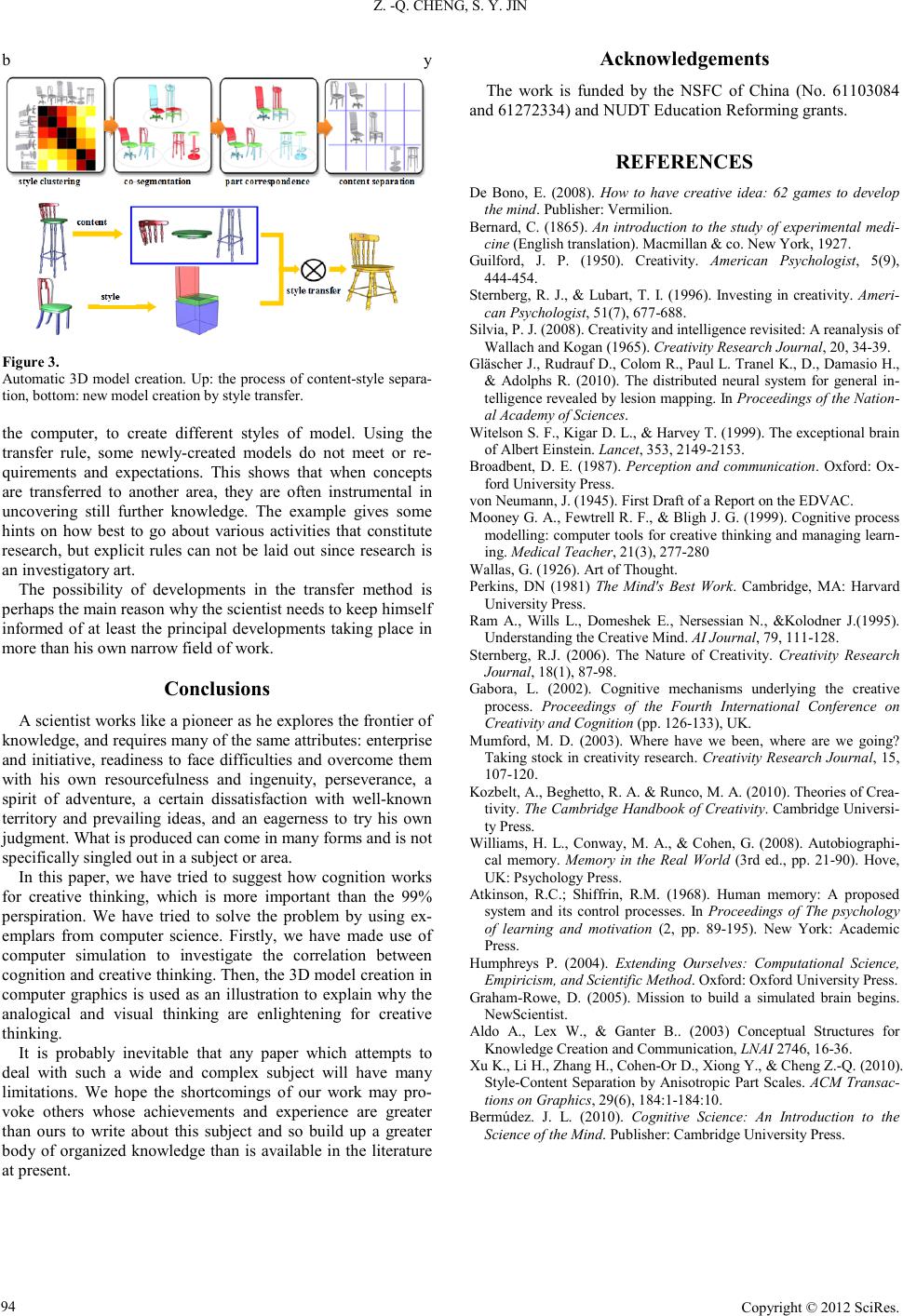 Z. -Q. CHENG, S. Y. JIN Copyright © 2012 SciRes. 94 by Figure 3. Automat ic 3D model crea tion. Up: the proc ess of conten t-style separa- tion, bottom: new model creation by style transfer. the computer, to create different styles of model. Using the transfer rule, some newly-created models do not meet or re- quirements and expectations. This shows that when con cepts are transferred to another area, they are often instrumental in uncovering still further knowledge. The example gives some hints on how best to go about various activities that constitute research, but explicit rules can not be laid out since research is an investigatory art. The possibility of developments in the transfer method is perhaps the main reason why the scient ist needs t o keep himself informed of at least the principal developments taking place in more than his own narrow field of work. Conclusions A scienti st works like a p ion eer as he expl ores th e front ier of knowledge, an d req uires man y of the same attrib u tes: en terp rise and initiative, readiness to face difficulties and overcome them with his own resourcefulness and ingenuity, perseverance, a spirit of adventure, a certain dissatisfaction with well-known territory and prevailing ideas, and an eagerness to try his own judgment. What is produced can come in many forms and is not specific ally singled out in a sub ject or area. In this paper, we have tried to suggest how cognition works for creative thinking, which is more important than the 99% perspiration. We have tried to solve the problem by using ex- emplars from computer science. Firstly, we have made use of computer simulation to investigate the correlation between cogn iti on and creati ve thinking. Then, the 3D model creation in computer graphics is used as an illustration to explain why the analogical and visual thinking are enlightening for creative thinking. It is probably inevitable that any paper which attempts to deal with such a wide and complex subject will have many limitations. We hope the shortcomings of our work may pro- voke others whose achievements and experience are greater than ours to write about this subject and so build up a greater body of organized knowledge than is available in the literature at present. Acknowledgements The work is funded by the NSFC of China (No. 61103084 and 61272334) and NUDT Education Reforming grants. REFERENCES De Bono, E. (2008). How to have creative idea: 62 games to develop the mind. Publisher: Vermilion. Bernard, C. (1865). An introduction to the study of experimental medi- cine (Englis h translation) . Macmillan & co. New York, 1927. Guilford, J. P. (1950). Creativity. American Psychologist, 5(9), 444-454. Stern berg, R. J., & Lubart, T. I. (1996). Investing in creativity. Ameri- can Psy chologist, 51(7), 677-688. Silvia, P. J. (2008). Creativity and intelligence revisited: A reanalysis of Wallach and Kogan (1965). Creativity R esearch Journ a l, 20, 34-39. Gläscher J., Rudrauf D., Colom R., Paul L. Tranel K., D., Damasio H., & Adolphs R. (2010 ) . The distributed neural system for general in- telligence revealed by lesion mapping. In Proceedings of the Natio n- al Academ y o f Sc ie nces . Witelson S. F., Kigar D. L., & Harvey T. (1999 ). The except ional b rain of Albert Einstein. Lancet, 353, 214 9-2153. Broadbent, D. E. (1987). Perception and communication. Oxford: Ox- ford University Press. von Neumann, J. (1945 ) . First Draft of a Report on the EDVAC. Mooney G. A., Fewtrell R. F., & B ligh J. G. (1999). Cognit ive process modellin g: computer tools for creative thinki ng and mana ging learn- ing. Medical Teacher, 21(3), 277-280 Wallas, G. (1926). Art of Th ought. Perkins, DN (1981) The Mind's Best Work. Cambridge, MA: Harvard University Press. Ram A., Wills L., Domeshek E., Nersessian N., &Kolodner J.(1995). Understanding the Creativ e Mind. AI Journal, 79, 111-128. Sternberg, R.J. (2006). The Nature of Creativity. Creativity Research Journal, 18(1), 87-98. Gabora, L. (2002). Cognitive mechanisms underlying the creative process. Proceedings of the Fourth International Conference on Creativity and Cognition (pp. 126-133), UK. Mumford, M. D. (2003). Where have we been, where are we going? Taki ng stock in c reativit y res earch . Creativity R esearch Jou rnal, 15 , 107-120. Kozbelt, A., Begh et t o, R . A. & Runco, M. A. (201 0 ). Theories of C rea- tivity. The Cambridge Handbook of Creativity. Camb ridge Universi- ty Press. Williams, H. L., Conway, M. A., & Cohen, G. (2008). Autobiographi- cal memory. Memory in the Real World (3rd ed., pp. 21-90). Hove, UK : Psyc ho logy P res s. Atkinson, R.C.; Shiffrin, R.M. (1968). Human memory: A proposed system and its control processes. In Proceedings of The psychology of learning and motivation (2, pp. 89-195). New York: Academic Press. Humphreys P. (2004). Extending Ourselves: Computational Science, Empiricism, and Scie ntific Method. Oxford: Oxford University Press. Graham-Rowe, D. (2005). Mission to build a simulated brain begins. NewScientist. Aldo A., Lex W., & Ganter B.. (2003) Conceptual Structures for Knowledge Cr eation and Communication, LNAI 2746, 16-36. Xu K., Li H., Zh an g H., Cohen-Or D., Xion g Y., & Cheng Z.-Q. (2010). Style-Content Separation by Anisotropic Part Scales. ACM Transac- tions on Graphics, 29(6), 184:1-184:10. Bermúdez. J. L. (2010). Cognitive Science: An Introduction to the Science of the Mind. Publisher: Cambridge University Press. |

